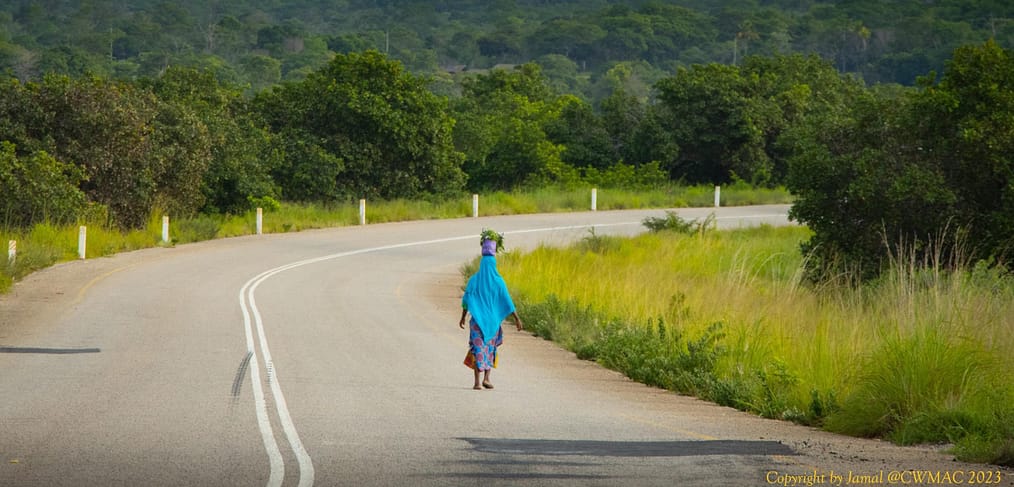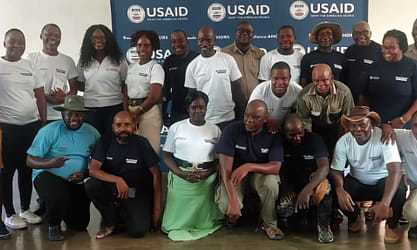
Improving Governance of Community Wildlife Management Areas in a key Wildlife Corridor in Tanzania
Community Wildlife Management Areas (WMAs) in Tanzania are lands designated for wildlife conservation and managed by rural communities. Every five years, the villages associated with particular WMAs elect leaders to run their Community-Based Organisation (CBO) that is recognised by government as an Authorised Association mandated to manage their WMAs. Well-managed WMAs should achieve the twin goals of wildlife conservation and generating socio-economic benefits for community members.
Five community WMAs – Chingoli, Kimbanda, Kisungule, Mbarang’andu and Nalika – are located in the Ruvuma region. These WMAs are located within the Niassa-Selous Trans-frontier Conservation Area (TFCA) between Selous Game Reserve in Tanzania and Niassa National Reserve in Mozambique.
Together, these five WMAs cover over 8,100 square kilometres, where over 75,000 people live alongside wildlife within a wildlife corridor that is critically important for the ecological functioning of the TFCA. This is one of the longest wildlife corridors used by savannah elephants in Africa.
Providing support for community WMAs
Despite the conservation importance of this area, these WMAs have not yet been developed to the point where they are financially successful, socially valued and provide long-term environmental protection. The Community Wildlife Management Areas Consortium (CWMAC) has therefore partnered with the Honeyguide Foundation in a European Union-funded project to assist these communities with reaching these goals.
Our joint project has five core goals:
- Introduce professional management and good governance practices at the WMA level;
- Develop sustainable nature-based enterprises and long-term partnerships to provide the necessary funding for the WMA to cover their operational costs and provide community services;
- Develop programmes that will provide valuable social services to the WMA communities to improve their livelihoods;
- Introduce regular and transparent communications between the WMA and its stakeholders using various communications media following a strategic communications plan;
- Develop strategic and cost-effective environmental protection initiatives to protect and conserve the WMA’s natural resources.
Selemani Omary Paswele, Secretary of the Chingoli WMA, welcomed the initiative, saying: “The Honeyguide Foundation’s work resembles the bird called “Ndegule” (a local name for honeyguide bird) whose function is to show an animal or human where honey is. Honeyguide have come to show us the way; when they see that we are ready and capable of managing our areas they will leave and we will continue by ourselves.”
Assessing the current governance of community WMAs
The first step in this project was to assess the current governance of the five target WMAs in the Ruvuma region. CWMAC and Honeyguide conducted this assessment using methodology called “Site-level assessment on governance and equity” (SAGE). The International Institute for Environment and Development (IIED) developed SAGE in 2019 for the purpose of assessing governance of protected and conserved areas and was therefore ideal for our purposes.
Using SAGE involves a stakeholder-led, self-assessment process to assess the quality of governance and equity using a framework of ten principles of effective and equitable governance. In each WMA, we conducted a stakeholder analysis, prepared a site profile, and finally held a two-day assessment workshop with stakeholders.
This was the first time all of the key stakeholders involved in each of the five WMAs were brought together to discuss such matters. The final outcome of the SAGE process informs planning, strategy, reporting, and policy development at the system, national, and global levels.
As Alfred William Rugarula, an officer in the Tanzania Forest Service, stated: “The SAGE training has been really participatory, because all key actors have been involved – something which is rare – so am suggesting that we should keep on collaborating like this, and those who participated should be good ambassadors back home.”
The two-day workshops held in each of the five target WMAs were attended by:
- 15 representatives of the WMA Authorised Association and its board of trustees;
- 5 Management and Village Game Scout representatives (staff working in the WMA);
- 5 Government representatives;
- 20 local community members who are not involved in the management of the WMA (10 men, 10 women);
- 5 representatives of investors and non-governmental organisations (NGOs) operating in the area.
During the workshop, five stakeholder groups used the SAGE questionnaire to score the WMA on each of the 10 SAGE principles of good governance. Each group had to provide a rationale for their scores, and later discuss reasons for differences in scoring with the other groups. They explored whether consensus could be reached for each score and identified actions to improve governance and equity.
Challenges and recommended actions
This process highlighted common challenges faced by all five of the WMAs, which will need to be addressed in future. The lowest scores achieved related to the managing the negative impacts of wildlife conservation, especially those related to human-wildlife conflict. Another weak point was the lack of coordination and collaboration among different stakeholders. The WMA management and leadership have low technical capacity to achieve such coordination.
On the positive side, respect for actors scored highly, showing that human rights are respected and that there is fair recognition of all involved. The principle of benefit sharing was either not assessed or prioritised lowest, most likely because these WMAs have not generated socio-economic benefits yet due to the lack of investors.
Several actions were recommended in multiple WMAs:
- Introduce community awareness and education programmes to understand the value of wildlife and other natural resources for improving their livelihoods;
- Demarcate WMA boundaries clearly to minimise encroachment;
- Finalise new general management plans to enhance proper management of the area;
- Improve collaboration between WMA’s and NGO partners, investors and local government;
- Develop and strengthen communication systems to keep WMA stakeholders informed;
- Access finances for equipment to support the smooth implementation of activities in the WMA including human-wildlife conflict mitigation;
- Reinstate or start WMA meetings, regular patrols of the areas, and training on good governance practices for WMA leadership and management.
One of the workshop participants, Kulwa Laluka Mboje, a livestock-keeper from Mbatamila village reflected: “I’m happy that I got the chance to participate in this training, because it will help us when we go back to village, as a lot of citizens do not have this knowledge and they participate in destructive activities due to lack of knowledge. The community needs to know that encroaching in conserved areas either by burning charcoal or farming destroys the forest, and livestock-keepers grazing inside conserved areas also leads to destruction”.
Next steps
CWMAC and the Honeyguide Foundation are already taking the next steps in line with the recommendations given during the workshops. We have set dates for governance capacity building and trainings, allocated funds to support recruitment of management staff and equipment purchases, and started developing WMA guidance manuals. These manuals will be big step towards attaining the desired future of community WMAs in the Ruvuma landscape.
It is our hope that this partnership and collaboration will expand to reach more WMAs in future and that each of the target WMAs starts to generate benefits for their members. With the right governance in place, WMAs will be able to engage investors in hunting and photographic tourism. The presence of camps and lodges will provide opportunities for local entrepreneurs to sell their crafts and other goods and services. We want to ensure that these communities reap the rewards of deciding to set some of their land aside for conservation through the benefits generated for both current and future generations.
By: Community Wildlife Management Areas Consortium of Tanzania






